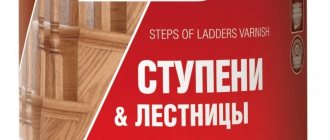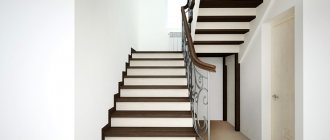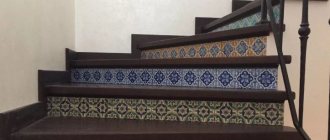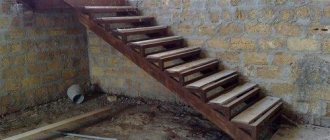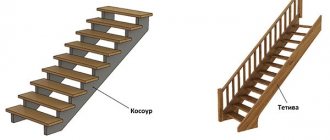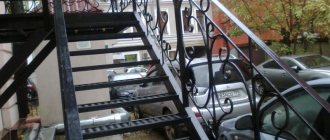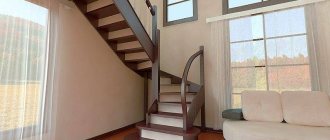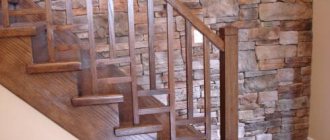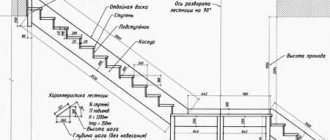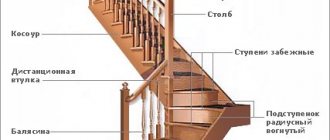Stairs occupy a significant place in the interior and exterior of the house. In addition to the fact that they add zest to the building, such structures also have a practical purpose, due to which they are subject to constant mechanical stress. One of the best options to improve the technological and aesthetic properties of stairs is to paint them. Read on to learn how to do this kind of work yourself.
Before painting the steps, you need to choose a suitable coating. It is selected depending on the material from which the staircase is made. You also need to consider where the structure you want to add color to is located. So, for stairs located indoors and outdoors, you need to choose completely different compositions.
What composition can be used to paint the stairs:
- Wooden and metal stairs can be painted. It is best to paint a wooden staircase leading to the second floor inside the house with alkyd compounds. For lifting structures located outside the dacha, drying oil-based paint is suitable. A metal staircase can be beautifully painted with special paints and varnishes.
- Enamel will not only add color to the staircase, but will also protect it from the adverse effects of the outside world. This product is a mixture of varnish and coloring pigments, so when it dries, it forms a colored waterproof film. If you are painting a staircase indoors with enamel, then choose compositions that do not emit harmful fumes.
- Stain allows you to give a wooden staircase a darker shade while maintaining its texture. With its help, you can make a larch structure look like expensive oak or mahogany. In addition to the decorative effect, stain has some protective properties.
- You can also decorate the stairs with varnish. It can be transparent or have a tint; in any case, this coating perfectly protects the wood.
You can paint stairs with any of the following compositions. Try to choose only high-quality coatings that meet all the properties stated on the packaging and do not emit harmful compounds.
How to paint metal stair steps
Metal stairs are often used outdoors, since metal is a durable and strong material that is resistant to most adverse environmental factors. However, such structures still have a drawback, because the metal is susceptible to corrosion, which makes it brittle and destroys it over time. High-quality painting will help to avoid problems of this kind.
With the help of a protective coating, you can not only increase the service life of a new metal structure, but also restore a country staircase that is already covered with rust.
In order for the paint to stay on the stairs for a long time, look perfect and protect the metal from rust, it is necessary not only to choose a high-quality composition, but also to carry out the finishing work correctly. Some will say that painting metal stairs requires the help of specialist painters, but you can easily handle this task yourself.
For painting you will need paint, degreaser and zinc primer. If you are going to restore an old staircase, then you will need to stock up on two sandpapers, fine and coarse.
3 secrets for painting metal stairs:
- If you want your painted staircase to look perfect, use spray paint or a spray gun. With the help of such devices, you can distribute the composition in an even layer, avoiding the formation of smudges.
- Use products containing zinc as a primer. They will not only help stop the process of metal rusting, but will also protect the structure from further corrosion.
- If you want the paint to lay on the restored staircase in an even layer, be sure to wipe the rust-free metal with a damp cloth.
Taking into account all the nuances and choosing the right equipment, you can beautifully paint the stairs without the help of painters. Also, to carry out such work efficiently, you need to know the order of actions that need to be performed when painting.
Sequence of painting work:
- Clean the stairs from rust using fine and coarse sandpaper;
- Degrease the surface of the structure;
- Shake the container with soil and, holding it at a distance of 25 cm, spray the contents in an even layer over the entire surface of the stairs;
- Paint the stairs with paint from a can or spray gun.
Metal stairs can be painted with a brush and roller. However, in this case it will be more difficult to avoid streaks and smudges. If you are not confident in your abilities, then it is better to purchase paint in cans.
A little about how to paint stair steps with varnish and stain
If you are a supporter of preserving the structure of wood, then varnish or stain would be the ideal option for your wooden staircase. They not only protect the structure from all sorts of unfavorable factors, but also give it a pleasant shade.
Varnishes for wood can be on different bases. All of them have a certain toxicity, which is why they can only be used in well-ventilated areas, after wearing protective glasses and gloves.
Types of varnishes that can be used for wooden stairs:
- Alcohol based varnish;
- Alkyd varnish;
- Nitrocellulose composition;
- Formaldehyde varnish.
Varnishes can be transparent or with a slight tint. The former are applied in two layers to protect the wood, and the latter are used to hide material defects.
You can also use stains. They also maintain the grain of the wood while adding an interesting touch to it. The most popular are stains of natural colors, but such products can be of absolutely any tone.
You can treat a wooden staircase with both varnish and stain. In this case, the structure will acquire a pleasant shade, and at the same time will be protected from the influence of adverse factors.
Before covering the wood with varnish or stain, it must be properly treated. This treatment includes sanding with fine-grained and coarse-grained sandpaper.
What color is natural wood?
In private low-rise buildings, mainly wooden or combined stairs are installed between floors, on metal frames with wooden elements.
Natural wood has a beautiful color, and on the surface nature leaves growth rings that form fancy patterns. In order not to spoil the wood, it is usually coated with colorless compounds that make the color deeper and the pattern more pronounced. Colored paints are usually used when it is necessary to hide defects in lumber or to give the surface a tone that matches the interior and a unique design idea.
When choosing a coating, consider the texture and color of the wood itself:
- Ash - a pattern in the form of long tongues is good in warm colors.
- Oak - color varies from white to almost black. The best decorative qualities are revealed by staining and etching. Over time, the wood darkens.
- Pine is bright and rich in color, but due to its high resin content, the surface is often uneven. With the help of modern coatings and painting technologies, pine can be painted in any color, imitating the texture of different species, for example, light/dark oak, red walnut.
- Pinkish beech will enliven a gloomy room. When treated with varnish, it almost does not lose its natural color, but over time it becomes reddish.
Secrets of painting wooden stairs
Coating a wooden staircase with paint will hide the texture of the natural material, but will give the product a gorgeous finish. You can paint wooden steps with a roller, brush or spray gun.
Secrets of painting a wooden staircase with paint:
- Before painting the stairs, carefully prepare the wood. Get rid of the old coating, putty and sand the product.
- If your plans do not include painting the walls and floor, then when covering the stairs with a colored composition, cover all surfaces with film. This procedure can be avoided if you paint the stairs before you finish the rest of the house.
- The stairs can be painted with a brush or roller, but using a sponge will allow you to avoid smudges and streaks. Dip the sponge into the paint, wring it out, and use gentle movements to cover the steps and railings.
You can paint a staircase in a variety of ways. The most interesting option is the antique effect, which can be achieved using brushing. A staircase painted in two shades of paint also looks very attractive; for example, the risers can be decorated with white and the steps with black.
Wooden staircase design
Many types of this material are used for stairs. It should be made from hard deciduous trees such as oak, ash, beech. Less commonly recommended are maple and cherry. You can also choose exotic woods such as merbau, amazake, zebrawood, wenge, jatoba or mahogany. However, it is not recommended to use soft wood - spruce, pine.
Wood is used to finish the steps of reinforced concrete stairs and to build the staircase as a whole - structures and steps. Staircase design options are modern and very popular. On the one hand, they are attached to the wall (on a steel cantilever structure), and on the outside, a light balustrade is mounted - most often metal (slings or rods) or glass. Wooden steps and risers seem to float in the air, creating an attractive shape that decorates the living room space.
Railings can also be made of wood. Balusters with milled recesses and curves, popular until recently, are going out of fashion.
Ideas for painting stairs in two colors (photo examples)
The staircase in a house is an important part, especially if the building consists of several levels. With its help you can not only climb to the next floor. It should become a unique element of the interior. Therefore, every owner of a two- or three-story private house needs to know how and with what to paint a staircase.
To give the staircase a finished look, several types of paint and varnish coatings are used. These are varnishes, impregnations and paints themselves. The first ones emphasize the structure of the wood (tinting) or fix the result (transparent), the second ones also emphasize the beauty of the wood pattern, but require additional fixing. The paints allow you to paint the stairs as you please.
Coloring is done not only for aesthetic purposes. On the floor, tongue and groove pine boards are most often used. Despite its strength, unopened wood wears out 5 times faster. This is due to the fact that dust and grains of sand become clogged in the pores, which over time destroy the structure of the floorboards. By painting a staircase made of pine or any other wood with varnish or paint yourself, you extend its service life.
stain
Stain is one of the cheapest compositions for covering stairs. Impregnation comes in different colors. It is designed to protect the wood and give it some shade. But it is better not to cover the stairs only with stain - after drying, you should use varnish.
It is customary to use a primer before applying varnish or paint, as it improves adhesion to the wood and makes the wood structure more uniform. If you tint the primer a little, you can emphasize the characteristic wood grain. The primer also contains substances that prevent the wood from rotting.
Clear/tinted wood varnish
Varnish is used to cover steps, balusters and railings. The colorless composition does not hide the wood texture. It is very important that the sanding of all elements of the staircase is carried out at the highest level. Transparent varnishes come in several types:
- Latex. Non-toxic material, safe for humans and animals. When applied to wood, it forms a thin, durable, water-resistant layer. It has antiseptic properties - protects wood from mold and rot. Can be used both indoors and outdoors.
- Water-based or acrylate. It has no unpleasant odor, is non-toxic, forms a fairly durable coating that is resistant to mechanical damage, and prevents the aging of wood.
- On synthetic resins. Such varnishes dry quickly, are resistant to aggressive environments (alkalies, acids), and are used only for interior work. Do not use synthetic resin varnishes to paint steps. They are suitable for balusters and railings.
- Yacht. There are different types, depending on the base - alkyd and its varieties (urethane-alkyd, alkyd-urethane) and acrylate. It is toxic, so when using it inside a living space, wear a respirator, otherwise the probability of poisoning is 99%.
Paste for covering stairs
Paste is considered an unconventional type of coating. It consists of linseed oil and beeswax. The consistency of the paste depends on the hardness of the wood. If the wood is hard, then there should be four times more linseed oil than wax. For soft breeds, use two parts oil to one part wax. You can make your own pasta or buy it at the store.
Surface treatment is quite simple: the paste is simply rubbed in, for this you need to use a natural lint-free cloth - this will make the surface of the stairs a little matte, with a silky shine.
Staircase lined with stone
Marble, granite, agglomerate, composite and porcelain stoneware are also used to finish staircase steps . In particular, the stone is very durable and resistant to damage and stains. Available in several dozen types and colors. Unfortunately, it is very heavy and not suitable for lightweight structures. Stone stairs add elegance to the interior, but do not make it warm and cozy like wood.
Agglomerate and composite are less popular, but equally effective and durable. They can imitate stone or have a plain colored surface. Porcelain tiles are a fairly cheap and practical finishing material, but they are not easy to arrange beautifully on spiral staircases or with narrow steps.
What to pay attention to
The criteria for choosing a certain type of paintwork for a wooden staircase are as follows:
- Floor load. If the stairs to the second/third floor are often used, then a wear-resistant coating is chosen.
- Tree species. Pine floors can and should be painted; larch boards have a beautiful pattern, so it is better to choose a colorless or tinted varnish.
- Availability of ventilation. The staircase, as a rule, is located near the entrance area, which means there should be no problems with ventilation. Therefore, you can choose any LMB.
- Price. The issue of saving is especially important if a lot of money has been spent on repairing or building a house. In this case, you can choose cheaper paintwork materials for the stairs, but not at the expense of the quality of the finished coating.
Space under the stairs: put to good use
So, we have already decided that the flight of stairs, and in a sense the analogue on the rails, takes up a considerable amount of space. Why not figure out how to put the remaining space to good use? Here's what can fit here:
Pantry.
If someone in the house is fond of preparing cucumbers or jam for the winter, then you can equip a pantry for appetizing supplies;
Laundry.
Household appliances require space. It is in the staircase that you can build a washing machine and dryer, and also take care of the placement of the ironing board, iron and household chemicals;
Cabinet.
A quiet corner is what you need for work and homework. You just have to take care of quality lighting;
Wardrobe.
You can store shoes and clothes in the stairs. Large storage systems will keep things tidy and clean;
Game room.
Children love all kinds of huts and shelters, so you can give this useful space to them.
8 Free Interior Design Software
Dyeing technology
Painting a wooden staircase takes place in 2 stages. This is preparing the base and, directly, opening the railings, balusters, and steps with varnish or paint. The first stage is very important; you cannot do without it if you want to get a beautiful and smooth staircase.
Preparing the base
To work, you will need a solution for wood putty or alternative methods of sealing cracks (wood chips, wood dust mixed with colorless varnish), an antiseptic primer, an iron brush, a spatula, sandpaper - 80, 100, 120, 180 - 220, 240 - 320 and zero.
The technology for preparing the base with your own hands is simple:
- Remove debris from the stairs and wash them with water. Then wait until it dries completely.
- Treat the steps with old paint remover. Using a spatula, remove the swollen coating. Remove what hasn't risen with an iron brush.
- Clean the steps, balusters and railings with sandpaper, or preferably two – first 80-grit, then 100-grit, remove dust with a brush, and vacuum the steps additionally.
- Seal the cracks. The putty will not last long if the stairs are actively used. Try sealing the cracks with wood chips. Select a piece according to the size of the hole, coat it with PVA glue and place it in place. Another way to seal cracks: mix wood dust with colorless varnish, seal the cracks with the resulting composition and let dry.
- Go over it again with 120-grit sandpaper, remove the dust and finish the job with sandpaper. Ideally, the steps, balusters, and railings should be smooth “like an egg.”
- Treat the stairs with an antiseptic primer. Use a roller for this. Make sure that the composition gets into all the recesses and decorations (if any).
- Wait for the primer to dry.
Now you can begin the final stage.
Paint coating
This is a crucial moment. The quality of the coating determines the appearance of the staircase and how harmoniously it fits into the interior of the house. To work you will need paint and a brush/roller. You can use a spray gun (it costs significantly more than conventional tools for applying paintwork).
DIY paint application technology:
- Open the jar. Using a long, strong wooden stick, stir the paint thoroughly. There should be no lumps in it.
- If the composition is excessively thick, dilute it with a solvent.
- Dip your brush or roller into the paint. Start painting. All movements should be along the fibers. After priming, the paint should not be absorbed too quickly. If you notice that the composition goes into the wood like a sponge, paint the entire staircase and wait until the first layer dries.
- Reapply paint. Pay special attention to the joints of the baluster/floor, baluster/railing, as well as various notches and squiggles (if there are shaped elements on the stairs).
Advice! After the paint has dried, open the stairs with clear varnish. This will increase the strength of the coating. As an option, paint only the steps, and varnish the balusters and railings.
Varnish coating
The preparatory work before such finishing is somewhat different. Sanding is carried out only once before the first opening. This is due to the fact that the varnish will inevitably raise all the fluff on the surface. Interlayer sanding will be required (180 - 220 sandpaper), and for the first layer it is better to use a special primer varnish.
Note. After stripping the primer varnish, the staircase is always a pitiful sight. It looks much worse than after removing the old paint. Don't be alarmed. A second coat of varnish, applied to a properly prepared surface, will do the trick.
Painting the stairs is carried out in steps:
- Prepare a clear varnish (if it is two-component, mix it with your own hands according to the instructions).
- Dip a velor roller into varnish.
- Start coating by running the roller along the grain of the wood.
- Let the layer dry. This is approximately 3 hours.
- Do another intercoat sanding. Use fine sandpaper (240 – 320).
- Apply a second coat of varnish. The third or more layers are applied only after the previous one has completely dried.
If you don’t like the natural color of pine, larch or other wood, use stain to make the stairs darker. You can apply an oil-based varnish, choosing the desired shade. It's up to you to decide which is better.
The drying time for the staircase depends on the number of layers of varnish. After a day, you can walk along it in socks or knitted slippers without hard soles. On average, the coating gains working strength in 7 - 10 days. In order to tidy up the staircase with your own hands and not spoil its appearance, you must have minimal skills in working with paints and varnishes. Follow the instructions exactly, and then the result will meet your expectations.
Stairs are very sensitive to the negative influences of the environment. And even if they are located indoors, they are still regularly exposed to changes in humidity and temperature; in addition, during cleaning, owners usually use detergents, which also have a negative effect on them. Therefore, in order to extend the service life of the structure, it is necessary to protect its surface with a reliable coating.
The most reliable and proven method of protection is painting. Moreover, every staircase needs it, regardless of the material from which it is made, be it metal, wood or concrete, since they all have their own weaknesses.
However, in order for painting to really cope with the tasks assigned to it, it is necessary in each individual case to choose the right type, since there is a large assortment of coatings on the market and they all differ in their properties. This article is dedicated to this topic.
Welcome to our page “Ideas for your staircase”!
I received a review from Victor (Thanks to him!) for this photo review!
Pros: Good day! I “accidentally” visited your site and... got great pleasure from seeing so many very interesting stairs. Comment: Thank you! With uv. Victor April 07, 2020 Victor
Arsenal Masters specialists have collected in this photo review interesting ideas for staircases for the home, amazing solutions, unexpected applications and simply beautiful staircases, made both by companies and by the hands of private craftsmen and the owners themselves, with imagination and love. * This photo review was created for informational purposes and is not a product. You can print this page yourself and for free.
We tried, as always, to provide information for your convenience concisely and concisely in the form of diagrams and photographs with small explanations. And we included more examples in the review - implementations of stairs. You can send your photos for placement on this page (preferably with an explanation of the photo and your information on how to identify you as the author) via the feedback form or e-mail. You can leave your comments in the review for this product page.
Quick navigation down the page:
- Types of stairs
- Basics of design and manufacture of stairs
- Design and design options for supporting elements: stringers and bowstrings
- Options for solving steps from different materials
- Options for design and design of risers
- Ideas and solutions for stair railings: railings and balusters
- Ideas for organizing the sub-staircase and peri-staircase space
- Staircase lighting ideas
- Schemes of stairs with dimensions for self-production
- Stairs in the interior of a country house
Types of stairs:
Let's start from the beginning - what types of stairs there are, all of them are shown in the diagram below and discussed in specific photo examples. The main types of stairs in shape when viewed from TOP differ in the trajectory of movement along them:
Option a) - Straight single-span (single-flight) staircase:
Marching straight stairs are the most common - they are simple and economical.
Option b) - Straight two-flight staircase:
Option c) - Corner two-flight staircase:
The design of a two-flight staircase consists of two, usually of the same length, flights and floor and interfloor platforms. The length of the staircase, and accordingly the area it occupies, can be significantly reduced by replacing the interfloor platform with several oblique (winder) steps. The winder steps make a simultaneous climb and turn, which makes the main spans flatter.
Option d) - Straight two-flight staircase with counter flights:
Option e) - Straight three-flight - U-shaped staircase:
Marching staircases come with both winder steps and interfloor platforms. In plan they can have L-, P-, T-, W- and Z-shapes.
Option e) - Curvilinear staircase:
Option g) - Spiral staircase with a central support:
Stairs consisting of only winder steps are called spiral or curved. Typically, a spiral staircase fits into a circle, the center of which is the support post. With steps 1 m wide and equal heights of risers, a spiral staircase occupies an area 1.5 times less than a marching staircase. However, with a step width of 1.5 m and equal riser heights, the areas occupied by the spiral and flight staircases are compared. Further increase in the radius of the spiral staircase becomes impractical, because it is significantly inferior to a flight of stairs in terms of comfort. When climbing a spiral staircase, one leg goes along a gentler slope, the other along a steeper one. And the closer to the center, the narrower the step becomes. For greater convenience, the steps of spiral staircases are most often made without risers.
Option h) - Spiral staircase:
A spiral staircase without a central post (support) is a spiral staircase. A spiral staircase inscribed in a circle is called a circular staircase, and one with variable inner and outer radii is called a pattern staircase. Patterned stairs, just like marching ones, are made in L-, P- or S-shapes.
Option i) - Patterned L-shaped staircase:
Options j) l) - Patterned and U-shaped stairs:
Basics of designing and manufacturing stairs
There are a lot of diagrams below, but it didn’t work out very briefly; for those who are not interested in the technical side of the matter, immediately follow the link further to Design options for the supporting elements of stairs Calculation of the sizes of steps and the slope of a flight of stairs When calculating the load-bearing capacity, the elements of the stairs are divided into statically definable beams - cantilever or single-span , and are calculated using the appropriate formulas. Since stairs are subject to dynamic loads, increased demands are placed on the rigidity of the load-bearing elements: their deflection should not exceed 1/400 of the span. The loads acting on flights of stairs and landings must be selected by adding the dead weight of the structures and temporary loads: in residential buildings this is 300 kg/m². When lifting, a person expends approximately twice as much energy as when moving horizontally.
A staircase is considered comfortable and safe if twice the height of the riser, added to the width of the step (tread), is equal to the average human step. The length of a person's stride on a plane is approximately 600–640 mm. Based on this, the tread and rise are determined by the formula: 2a + b = 600...640 mm.
As an alternative, you can use another, easier to remember, formula: a+b = 450 ± 20 mm, where a is the height of the step (riser), b is the width of the step (tread). The width of the tread should ensure that the foot rests with the full foot, that is, it should be no less than 200 and no more than 320 mm. The optimal riser height is 150 and the tread width is 300 mm. Important! If the tread width increases too much, you will certainly lose your step, and if the tread width decreases too much, descending will be difficult. When designing the winder steps of a spiral staircase, it must be taken into account that the minimum width of the steps at the narrow end should be at least 100 mm, and the overhang of the tread over the bottom step should be no more than 50 mm. The overhang of the tread over the bottom step is done to increase the width of the tread when other methods fail to increase its size.
The photo on the right shows the relationship between the tread width and the riser height in inches. The most convenient angle of rise of the stairs is in the range from 23 to 37°:
There is a rule: the steeper the staircase, the more compact it is and the less space it needs to be installed in the house, and vice versa, the taller the staircase, the more dimensions it needs to be provided for.
At an angle of less than 23°, the stairs can be replaced with a flat inclined platform - a ramp. If it is more than 45°, then the staircase becomes an extension or folding one.
The optimal angle of rise of spiral staircases is 25-35°. The most difficult process when the flight of stairs is steeper than 40° is descending the stairs, and at angles greater than 45° the descent can only be done backwards.
Recommended dimensions for the width of the flight of stairs: Determination of the height of the opening for the flight of stairs, along which furniture is supposed to be carried to the second and higher floors:
- - movable object - wardrobe, piano, etc. - 200x180x60 cm,
- - flight of stairs,
- - inclined ceiling of the next flight of stairs,
- - landing,
- - upper ceiling.
For stairs where only human walking is expected, as well as attic and basement spaces, the minimum heights may be lower:
Basic minimum dimensions for steep ladders: Recommendations for wood materials from which ladders are made. Wooden stairs are made from pine and oak, less often - from cedar, larch, mahogany, Oregon pine and araucaria (Brazilian pine).
- High-density oak wood is strong and reliable.
- Coniferous wood is softer than oak, but more convenient to process. It is better not to use coniferous wood, especially spruce, for making steps; due to their softness, they wear out quickly.
The humidity of the wood used to make the stairs must correspond to the humidity of the room in which it will be located.
Below is a table of the use of various wood materials for the manufacture of stairs: Features of the design of marching stairs: Features of the design of spiral staircases: Recommendations for sizes: Calculation of spiral staircases is made from the running line (strip) - the middle line along which a person moves along the stairs: To speed up the calculation of a spiral staircase it is more convenient to develop a staircase line along the outer edge of the steps: An example of constructing the heights of winder steps on a U-shaped spiral staircase: Dimensions and their ratios necessary for constructing a drawing of a spiral staircase with a “goose step”: Options for the design and design of supporting elements
There are two main varieties fastening steps on the stairs: using stringers or bowstrings: In one case, the steps rest with their lower surface on a support - stringer, and in the second - the step is attached to the side support element with its end. The picture shows typical options for a wooden bowstring: Attaching stringers: An example of marking a stringer for a staircase using a carpenter's square:
Stringers have a wide variety of designs. There can be one or several stringers. A variety of materials are also used for making stringers: wood, metal, reinforced concrete. The simplest stringer is made from a solid log or beam.
A curved string made of laminated wood certainly looks much more interesting: A staircase on two stringer logs is a reliable, simple and at the same time original solution:
Moreover, initially it is often used as a temporary solution, gradually turning into a permanent one: Stringers made of solid, or better yet, laminated boards:
Beam stringers made of laminated wood boards, located at different slopes on a spiral staircase:
Stacked stringer made from modular flat elements cut on a 3-D machine:
Nowadays, welded metal stringers are widely used:
There are stairs where the steps with risers themselves are stringers: Recently, modular stacked stringers from standard elements have become widely used. With their help, the staircase can take on a variety of shapes: from simple marching ones to complex curved ones.
Wooden modular stairs can be assembled from flat standard elements: Metal marching spiral and modular stairs:
Complex stringer: Staircases on a string: The classic flight staircase on strings is one of the most common stairs: But it can also be designed in a special way: Spiral staircases on straight strings are an economical and compact solution: S-shaped spiral staircases are an excellent solution when available restrictions on the area of staircase placement: A staircase with a curved bowstring is one of the most difficult and expensive to manufacture. But the beauty of curved surfaces always attracts the eye and speaks of the high professionalism of the craftsmen who make them:
Options for stair steps
The correct calculations for the size of steps and classic stairs are given above. Here we will show original ideas. The following stairs can serve as interesting solutions from the point of view of saving space: Roller boards - skateboards are used as steps: Massive wooden steps made of hewn solid logs look solid and brutal. Especially if they are made from noble species: oak and ash are the most suitable varieties for these purposes.
Steps made of solid solid timber:
Assembled boxes can also be used as steps:
Also, standard prefabricated elements can act as steps: The combination of solid expensive wood and natural stone looks great in the steps: The steps of the staircase can also be double-entry: Cantilever-fixed steps. Wooden cantilever steps: The most widespread are steps that are structurally a cantilever metal element, sheathed on the outside with plywood or board (laminated board). There are also wooden structures made from stacked flat elements that are attached to a string mounted in the wall: Cantilever fastening of steps on spiral staircases: on a string or a central support. Wooden stairs:
Stairs with a metal base:
Stone staircase: Exotic modern staircase with cantilever-fixed steps: Cantilever staircase made of steel sheet (“Dachny Otvet” on NTV): A compact structure was fit into the given very limited space so that the staircase does not clutter the room, while the first three entry steps of the staircase represent a module of a sofa podium: The staircase was designed taking into account the height of the ceiling and was made of steel sheet 6 mm thick. A single sheet was cut into blanks, which were then welded into a single structure with steps 80 cm wide. A staircase weighing 180 kg was attached on one side to support pillars hidden behind the wall sheathing. On the other hand, it is supported by a fence that was welded to the steps and the supporting metal strip on the second floor. Recently, steps made of tempered glass have become widespread, giving the interior airiness and lightness:
Options for the design and design of stair risers
The riser space can be filled with ceramics and tiles:
In this case, the staircase supports the interior design, for example, in the Spanish or Moroccan style:
The risers can be decorated using photo collages:
Thanks to the design of the risers, the stairs reflect their owners: You can make your home staircase in a book theme or part of a library:
By the way, antique replicas of mobile book ladders can be useful in your home library:
The risers can be decorated with artistic carvings: Follow the link - carving tools and carving kits. Mosaic, colored stone and glass will make any staircase more interesting:
Acrylic frosted glass in combination with wooden steps looks very modern and practical.
Ideas and solutions for stair railings: railings and balusters
Features of railing design:
The procedure for marking and installing fences:
Options for supporting wooden balusters:
Options for balusters made of different materials: Sectional shapes of railings:
Design solutions for railings: Options for fastening balusters, railings: Design of the rotation of the fence: Options for stair railings, taking into account the use of a variety of materials: More options for railings:
Modern technologies make it possible to use glass stair railings as a fairly safe and certainly beautiful solution:
Forged stair railings:
Wooden fencing, of course, is the most popular and most diverse: Follow the link - Review of Super Connections 2.0
Decorating the Bottom Support for Stair Railings:
Staircase Lighting Ideas
Firstly, it is always best to make the most of the natural lighting in your staircase. This is both savings and beauty at the same time.
Local light at night is both safety and, again, beauty. Lighting can be installed in the risers using LED strip:
You can install lamps at the ends of the steps:
The end lighting of glass steps looks great. The optical effect scatters light over their entire area:
Or provide lighting along the entire staircase in a light box or railing:
The lighting was mounted at the bottom of the handrail itself:
Side lighting also looks impressive: Installing classic local lamps will always remain in fashion:
Proper street lighting will help create a special spiritual mood:
Ideas for organizing the space under and around the stairs
: Any staircase, both simple and the most elaborate, should fit harmoniously into the interior. Otherwise, it will not only not be pleasing to the eye, but can also create serious problems during its operation. From the inability to install any furniture or decorative elements at its location - to injury to your loved ones on such stairs. Therefore, it is very important to design the staircase initially together with the surrounding interior, and not try to fit it into the existing one. If it so happens that you need to make a staircase or modify an existing one in accordance with the surrounding interior, then you should adhere to several rules.
- The materials of the stairs and the surrounding environment must be combined with each other. For example, an all-metal staircase will look alien in a room decorated only with wood. Or if your interior is lined with cheap pine paneling, then
- The colors should also be mutually harmonious with each other. In the example below, the staircase harmonizes well with the floor both in color and material. But against her background the walls look alien and cold.
The styles in which the staircase is made and the surrounding interior must also match. For example, the style of this staircase is clearly different from the interior and hurts the eye. This difference in a given interior can be compensated for, for example, by door frames painted in the same style.
Elements of the staircase should not limit the functionality of the existing interior, or at least this should be reduced to a minimum. For example, it is advisable to avoid such a solution - a handrail partially blocks access to the window.
But the solutions, ideas and finds below not only please the eye, but also functionally expand the possibilities of the interior: 1. Wardrobe / storage system under the stairs
2. Office with stairs / area for desk and work under the stairs:
3. Place for relaxation and reading under the stairs
4. An excellent solution is to place a relaxation area with a fireplace in the space under the stairs:
The idea is to combine a fireplace, or even a stove, with a staircase - you get a cozy and warm space:
5. A wine cellar or a bar under the stairs would also be appropriate:
6. A children's playhouse is ideally located under the stairs:
In the version below, the children's house has its own special staircase and at the same time the entire object succinctly occupied an empty corner near the main staircase: Staircase with a slide for children:
7. The owner will always think about the dog - a booth under the stairs - why not?: 8. And of course, we are all familiar with the solution of placing a toilet under the stairs. And this solution can be played out beautifully:
More ideas for organizing the space around the stairs. The solution to an invisible staircase combined with a work desk and a library looks easy and modern:
And finally, the ideal stylistic device is when the staircase is completely integrated into the overall interior. This interior creates a feeling of comfort, coziness, beauty and safety:
The unity of the style solution is the key to successful perception of space:
Diagrams with dimensions for self-production
Example of a U-shaped spiral staircase in a room with a ceiling height of 3.25 m:
Stairs in the interior of a country house
In conclusion, here are a few photos of magnificent stairs in different styles, when the design looks organically in the space of a country house:
A staircase as part of the interior of the first floor, when the kitchen - dining room - living room are combined in an open space and harmonious style: Staircase in the interior of the kitchen and dining room:
Staircase in the library:
Elements of stairs in furniture:
More photos of beautiful interiors of houses with stairs: We hope our photo review of stairs will be useful to you!
Basic requirements for paint
When choosing paint, first of all you should pay attention to the material from which the staircase is made, in what conditions it is used, what requirements are imposed on the coating, and what you want the structure to look like in the end.
As a rule, the coating for stairs should have the following properties:
- Good adhesion to the base;
- Water resistance;
- Resistance to temperature changes;
- Wear resistance;
- Radiation stability;
- If the structure is located outdoors, then frost resistance is also important;
- Anti-corrosion properties (for metal stairs).
In addition, sometimes other requirements are imposed on paints, for example, fire retardant properties are sometimes important. In this case, specialized compounds are used, such as fire-retardant paints for metal Polistil.
Choosing lighting for the stairs
An internal staircase is not only a spectacular decoration, but, above all, a means of communication. This means it must be safe. In addition to the requirements for a convenient shape, number and height of steps, it must be properly lit.
Lamps can also perform decorative functions, emphasizing the original design and the nobility of the materials used. The light should be planned in such a way that it falls on the steps.
There are several options for choosing the type of lighting for the stairs:
- wall lamps - should be hung on the walls above the view of the household member climbing the stairs;
- grommets in the wall - attached to the wall every third step;
- staircase lighting - mounted in the plane of the stairs, in the risers, preferably under each one; it can be in the form of eyelets, LED strips or strips.
Types of paints
So, today, as a rule, the following types of paintwork are used for painting stairs:
- Alkyd enamels;
- Water-dispersible acrylic;
- Polyurethane;
- Oily;
- Transparent varnishes.
Of course, there are other types of coloring compositions, however, the above types have recently been the most popular. Now let's take a closer look at the features of these coatings.
Alkyd enamels
This type of dye is one of the most universal. Do-it-yourself painting of stairs with alkyd enamels can be done, regardless of the type of material from which the structure is made.
In addition, the coating has some other advantages, in particular, these enamels are distinguished by their decorative properties - .
These compositions are based on alkyd varnish, to which various solvents, fillers and coloring pigments are added. The filler is usually granite or marble chips, as well as quartz sand. It should be noted that the filler is much finer than regular sand.
Sometimes manufacturers add additional substances to the paint that give it one or another property. For example, the composition may contain antiseptics to protect wood from the formation of fungus and rotting.
In addition to the fact that these coatings meet all the above requirements, they also differ in the following properties:
- Elasticity;
- Durability;
- High drying speed;
- Do not crack;
- They don't sit down.
Thus, alkyd enamels are excellent protection for metal, wood or concrete surfaces. Moreover, painting the stairs can be done both indoors and outdoors.
The only drawback of the coating is the strong toxic odor, which gradually decreases as the paint dries.
Advice! To dilute thickened alkyd enamels, you can use white spirit.
Acrylic paints
Water-dispersible acrylic paints have become the most popular lately. Their main advantage is environmental friendliness. The composition is completely odorless, since ordinary water is used as a solvent, and acrylic resins act as a binder.
Thanks to this, before painting the stairs in the house, your loved ones don’t even have to leave their home.
In addition, acrylic compositions have other advantages:
- Excellent covering power.
- They dry quickly - the hardening process lasts as long as the water evaporates.
- After the composition hardens, a plastic coating forms on the surface.
- Initially it has a white color, which allows you to achieve any shade by adding colors.
- The composition does not fade or fade in the sun.
- It has good moisture resistance, resistance to temperature changes and frost resistance, so it can be used for external stairs.
- You can use acrylic paint to paint a metal, concrete or wooden staircase yourself.
Note! Before purchasing acrylic paint, you should clarify the scope of its application, since usually these compositions are narrowly targeted. This information is contained in the instructions on the package.
Polyurethane coatings
Polyurethane coatings are also very popular, which can be used to treat both wooden and metal surfaces. Due to their good resistance to mechanical loads, painting of staircases is usually done with these compounds.
When the paint, which is based on polyols and hardeners, dries, a durable coating is formed on the painted surface, which is highly resistant to atmospheric influences. Thanks to this, polyurethane compounds can be used for outdoor use.
Among other advantages of the coating, the following points can be highlighted:
- Resistant to mineral and organic oils, acids, gasoline and oxidizing agents.
- Excellent adhesion to the base.
- After drying, a wear-resistant, elastic and at the same time hard film is formed on the surface.
- The composition is non-toxic.
- Does not fade in the sun.
- Has good frost resistance.
Therefore, if the staircase will have high traffic, you can opt for polyurethane paints.
Advice! For coating exterior metal stairs, Zinga conductive paint is also an excellent option. It provides a high level of corrosion protection and has a long service life.
Oil paints
This type of paint is used less and less, as it has gradually been forced out of the market by more “advanced” compositions, which we discussed above. But, despite this, even now you can find use for oil paint. For example, this composition can be used to paint a pine staircase, especially if you are not sure that the wood has dried well.
This is due to the fact that oil paint and the resin released by coniferous wood have almost the same composition, due to which the coating will adhere well, unlike many other paints. In addition, external metal structures can be coated with oil paint.
True, before painting a metal staircase, it needs to be treated with a primer so as not to encounter corrosion in the near future. Another advantage of these paints is their low price. They are much more affordable than the ones listed above.
In the photo - covering the stairs with transparent varnish
Clear varnishes
Finally, it must be said that when processing wooden stairs, transparent varnishes are very popular. Like paints, they can have different characteristics that you should pay attention to when purchasing. In addition, some of them contain pigments, which allows you to give the surface a certain shade and highlight the texture of the wood.
As a rule, such coatings are used for interior work to preserve the natural appearance of the stairs.
Railing options
Railings are components of staircase structures that perform the following functions:
- serve for convenient, safe ascent and descent;
- act as decoration.
The design of the railing includes handrails and balusters. By handrail we mean a bar that runs along the flight of stairs. A baluster is an element that performs the function of supporting a handrail.
The construction market offers a wide selection of railings. They come in different models:
- Aluminum and stainless steel. Their main advantage is an aesthetic appearance, reasonable price, long service life, and ease of maintenance.
- Forged. The main criterion for choosing such products is beauty and grace. They are created by hot and cold forging.
- Wooden. They are environmentally friendly, attractive in appearance, and have a wide selection of colors.
- Stone and concrete. The main disadvantage is the heavy weight, the advantages are durability and strength.
- Glass. Fragile-looking products are characterized by durability. They are easy to install and dismantle. However, along with the advantages, there are disadvantages: high cost and difficult maintenance.
- Combined. These are railings that combine different materials. For example, forged balusters and wooden handrails.
The choice of one or another version of the railing depends on the style of the interior and the taste preferences of the owner of the house.
Conclusion
Today there is a large selection of paints, which allows you to select the composition in accordance with all the requirements for the coating. Therefore, before making a choice, you need to think carefully about the operating conditions of the ladder.
The correct choice of paint will significantly extend the life of not only the finish, but also the structure itself. Additional information on this topic can be obtained from the video in this article.
Painting a staircase is not as simple a task as it might seem at first glance. This process has many subtleties that only professionals know. These are the kind of employees who work in ours. By contacting us for services, you will get an impeccable result at a relatively low cost.
Options for painting wooden staircase elements
Video description
For options for choosing the design of stairs, watch this video:
The following stylistic techniques stand out:
- A classic color combination, when a light staircase is combined with dark tones of the floors (classic style).
- High-tech style - white treads in combination with dark risers (white - black, light - gray), with black handrails. Matte and glossy combinations of coatings give a special character to the design.
- “Country style” – glossy, bright and sunny combinations with lush, soft tones and shades.
- In the “minimalism” style – matte finishes combined with discreet tones of calm colors.
- “Traditional” style – varnished treads and handrails in combination with painted risers. The balusters are also varnished. Traditional color combinations for wooden parts are white, beige, peach, olive. You can experiment with incompatible colors: red - green, yellow - blue, orange - brown.
Fantasy painting style Source yapx.ru
Painting wooden stairs
It's no secret that wood is very popular.
The wooden structure in the house can last a long shelf life if it is properly and efficiently processed. Various paints, varnishes and environmentally friendly oils come to help here. These chemicals not only provide aesthetic beauty, but also play a protective function against the negative effects of the environment.
There are quite a few products that are used to paint wooden structures and each of them has its own pros and cons.
- Oil paints. They are made on the basis of natural and artificial drying oil. Stores sell both ready-made oil products and thick grated ones that require dilution. In general, this is a budget solution, but it has disadvantages: it takes a long time to dry and does not withstand mechanical stress;
- Varnishes are divided into two types: water-based and two-component (polyurethane);
- Enamel. This substance is not suitable for outdoor wooden structures, since the enamel does not withstand high humidity, it also has a fairly dense (opaque) structure and therefore completely hides the wood texture;
- Impregnations. Can protect against most harmful influences.
For finishing carried out inside a wooden structure, it is important to carefully select paint and varnish products. During the actual use of the house, paint evaporation will be constant. It is important that this does not harm the people living in it.
BIOFA waxes and oils are made from natural ingredients. Without affecting people's health, BIOFA products contribute to an optimal microclimate in the home.
Wooden stairs that are used in such buildings also require enhanced protection. During operation, products are subjected to significant loads. BIOFA waxes and oils are perfectly absorbed by wood, creating a reliable, elastic, wear-resistant microscopic coating. The surface of wooden structures acquires dirt- and moisture-repellent properties, becomes resistant to low/high temperatures, and is easy to maintain. If a section of the staircase is damaged, only local restoration will be required. Re-sanding the entire structure would not be appropriate.
Wood treated with BIOFA oil ensures optimal humidity and air exchange in the premises of a wooden house.
Applying the product to wood, regardless of whether it is beech, ash or pine, is a long, responsible and careful study of every detail. This requires special knowledge of the properties of dyes and wood species. Ignorance of special nuances can lead to cracks, stains, stains and other defects on the structure. Therefore, it is better to even pay a slightly higher price, but turn to competent specialists. In any case, the price of painting a wooden staircase will not seem higher than the cost of correcting mistakes.
Popular staircase styles
Nowadays, there are many options for staircase styles. Their number is constantly changing, as design elements are improved and supplemented, creating a completely new style.
However, it is customary to highlight several of the most well-known approaches:
- Provence. Such staircases differ from others in their light tone, brevity, lightness, and monotonous balustrade. Structures in this French style are usually made of wood or stone. Admirers of this style are calm, self-confident people.
- Loft. It is characterized by clarity, straightness of contours, and rough shapes. In structures of this type there are no closed railings or figured balustrades. Due to the rough steps made of wood, this style will never be confused with another.
- American style. Wood, stone, metal, and organic matter are used to make structures. Looking at such a structure, one gets the impression that it can breathe.
- Scandinavian style. Its main features are contrasting colors, massive construction, and no-frills design. A white staircase in a Scandinavian style in a wooden house looks especially impressive.
- Classic. Calm structures made of natural stone, expensive wood and forged decorative elements give the interior sophistication and elegance.
- Chalet style stairs. They are installed in country houses and dachas. They can be rotary, screw, winder, single-flight, L-shaped.
Painting a wrought iron staircase
Forged structures have many advantages, but they also have disadvantages: the metal is naturally dark in color and tends to rust quickly. These two disadvantages can be easily eliminated by painting. How to properly process metal?
- First of all, before starting work, it is necessary to treat the metal with a primer;
- The coloring agent must be of high quality and protect the forged product from the harmful effects of the environment and corrosion;
- Before applying the required amount of product to the entire surface, you need to test it, that is, apply it to a small area and, after drying, make sure that the color suits you;
Technology for applying powder paint to a metal structure:
By following these rules you can achieve a successful result.
In order to give a beautiful appearance, you will need to paint the stairs yourself. ,
It also allows you to save a lot of money that would have to be paid to specialists performing painting work. In order to paint a staircase with high quality, you need to choose the right paint, the right tool and adhere to certain rules.
Features of painting stairs
- brushes or spray bottle;
- paints and varnishes;
- paint container;
- priming.
The first stage of painting is to apply primer to the surface of the stairs. Priming is necessary in order to remove minor surface defects or make them less noticeable, as well as to ensure good adhesion of the paint to the surface of the materials. Without a primer, more coats of base paint will be required, which can significantly increase the cost of the job.
The painting procedure may vary depending on the material the staircase is made of, and the primer, paint and varnish are also selected depending on the material.
Painting a wooden staircase
Wooden stairs can be painted or varnished. If the staircase is made of high-quality noble wood, then it is best to varnish it, leaving the natural beauty of the material and protecting it from external influences. If the wood used is not of the highest quality and has various defects, then it would be better to choose paint that can hide many unattractive places.
If you decide to varnish, then you need to choose the right varnish. The most practical would be a matte or semi-matte varnish, which can be used to varnish steps, railings and other elements. Glossy varnishes on elements with a high degree of wear quickly lose their properties and especially their shine.
If desired, you can change the color of the wood without hiding its texture. To do this, you can cover the material with stains, thanks to which you can darken the wood and give it the desired color. After applying and drying the stain, the material is varnished with colorless varnish. To completely paint wood, drying oil paints are used. The best option for decoration and protection are enamels that combine the properties of paint and varnish.
Having decided on the materials, you can begin the process of applying paints and varnishes. In the case of a wooden staircase, it is best to do this with a brush. You need to have several brushes of different sizes on hand to make painting hard-to-reach places easier, you will need a thin brush.
Wood is painted in several layers, the number of which depends on the tree. This is due to the fact that wood absorbs paint to varying degrees. Subsequent layers are applied after the first has dried and absorbed a little.
Painting metal stairs
If you are painting a metal staircase yourself, then you need to buy a primer for metal and carefully prepare the surface, cleaning it from rust and other contaminants.
Primer and paint are best applied with a spray gun, which will make the surface smoother and more uniform. If it is not possible to use this tool, then you can get by with a regular brush.
For thick paint, it is better to use a brush with round bristles, and for thinner paint, a flat and soft brush is best.
Important!
For comfortable painting, it is best to buy high-quality brushes of various types and sizes, which will ensure ease of work and faster painting speed.
Where to start painting
When painting a staircase with your own hands, the video will help you complete complex painting without outside help, efficiently and quickly
You can start painting from the top step and gradually descend into them. At the very beginning, you can paint the railings, and then move on to the steps. This is more convenient, because if you paint the steps, you will not be able to walk on the stairs when working with the railings.
Important!
The quality of painting largely depends on how well the surface is prepared and the instructions for using paints and varnishes are followed.
When painting a staircase with your own hands, taking photos of the work will allow you to quickly navigate and do the work better and faster.
After completing the painting work, you must wait until the paint or varnish is completely dry. It is recommended to wait a little longer than recommended by the manufacturer of the paints and varnishes used. This will guarantee maximum strength of the coating and its durability.
